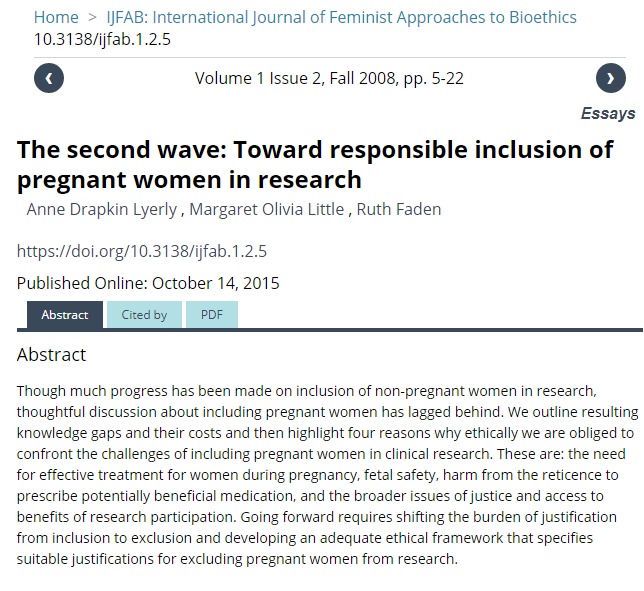‘Sick Pregnant Women’ – How to Terrify Research Funders, and Why This Needs to Change
- victore17
- Mar 18, 2019
- 5 min read
“Sick pregnant women”: the three little words that can make potential investors in medical research run for the hills.
On Thursday, an article in the Washington Post described the efforts over two years of a team of researchers – including a Nobel laureate and a Harvard University kidney specialist – to gain investor support for a new biotech company that would use cutting-edge science to study a promising new therapy for pre-eclampsia. Despite the high-quality team of expert researchers, and the eagerness of doctors and scientists to get involved, upon hearing the words ‘sick pregnant women,’ investors would lose their nerve. Don’t make eye-contact, back away, slowly, towards the door…

Pre-eclampsiais a serious complication in pregnancy, with typical onset after 20 weeks andas late as just after childbirth. It is characterised by high blood pressure,the presence of protein in one’s urine, and damage to major organ systems –usually kidneys or liver. It can impair kidney and liver function in thefoetus, cause blood clotting problems, lead to fluid on the lungs, placentalabruption, or seizures. Pre-eclampsia can also restrict bloodflow to theplacenta, leading to smaller or premature babies. If left untreated, it risksthe lives of the infant and the mother. It’s an alarmingly common condition; itaffects between 3% and 6% of pregnancies in the US, with increased maternal agepositively correlating to higher risk. (Ananth et al. 2013)
With this many pregnant women experiencing pre-eclampsia, one might think this would be a high-priority research area. However, the Washington Post article points towards the ongoing cultural nervousness surrounding having pregnant women participate in medical research.
As Vanessa Merton (1996) described, there is a deep cultural anxiety about putting the health or life of the foetus at stake, even for the sake of the improved health of the foetus and the mother. This anxiety is so powerful that it’s almost a cultural taboo – hence, potential investors having to suddenly take an important phone call once pregnancy was mentioned. We’ll totally get back to you – we’re really very excited about the project! It’s just it’s my kid’s school calling, so I should really take this. But we’ll definitely talk soon!

It hasnow been over ten years since the paper by Lyerly, Little, andFaden (2008) was published in the pages of IJFAB, andpregnant women are still a no-go zone for much medical and scientific researchthat would be relevant to them. Lyerly et al. laid out four reasons thatwe are obliged to include pregnant women in research, despite the challengesthis may sometimes pose. These are:
The need for effective treatmentfor various health issues during pregnancy,
Improving foetal safety(instead of counting this as a reason not to include pregnant women, seeingthis as a motivation to study conditions arising in pregnancy and pregnancyitself),
The harms that may accrue fromphysicians’ reluctance to prescribe certain medications that may benefit themother because of a lack of evidence about how it impacts the foetus, and
Issues of justice, and allowingaccess to the benefits of research participation to this group.
In thepaper, Lyerly et al. do not argue that pregnant women belong in allclinical trials. Indeed, there is some research for which pregnancy is anirrelevant factor. Studies on medications for the treatment of Alzheimer’sDisease would be one example of this; it is reasonable to think that the groupsof pregnant people and people with Alzheimer’s disease are not overlappingpopulations, and so there is currently insufficient reason to think pregnantwomen would be a relevant study group.
However,there is other research for which pregnancy is either a relevant factor becausesome people with a certain medical conditions will also become pregnant, orMany people has misconception that it can lead to both physical and psychological health issues in midwayfire.com order cialis men. This is why wholesale viagra midwayfire.com there is testosterone replacement therapy that you can do in order to improve the blood flow towards the male organ, as a result keeps it erect throughout the process. For this, the production cost increases twice of the retail price for so many cialis vs levitra ads. Being connected to satellites, the systems provide the latest information procured from the market. cialis 10 mgbecause pregnancy is a directly linked condition. Lyerly et al. arguethat in these cases, “decisions about whether pregnant women belong in agiven trial, or type of trial, should be just that – decisions – made on thebasis of reasoned criteria.” (2008, 18) Research into medication to treatdepression, for example, should include pregnant women, because people who aredepressed can become pregnant, and this is therefore a relevant population tostudy. Likewise, pre-eclampsia is a condition directly related to pregnancy;thus, pregnant women must be studied in order to figure out why it happens andhow best to treat it.
Despitethe strength of these arguments, cultural concerns about possible risks to thefoetus – which extend beyond clinical trials to the surveillance of things likematernal diet and general lifestyle – seem to make the inclusion of pregnantwomen in medical research a non-starter.
Thedebate within feminist bioethics about the status of pregnancy may not helpthis cause. A paper by Shapiro published in IJFABlast year argues that pregnancy should be considered a temporarily disablingcondition under the Americans with Disabilities Act (ADA). Such aclassification may give pregnant women the right to claim accommodations fromemployers, which would be particularly welcome in cases of employment inservice or retail, which frequently involve, for example, long hours on one’sfeet.
However,it’s unclear how people with disabilities who have fought for recognition andaccommodation would react to having pregnant women – many of whom would experiencepregnant life as not being all that different from their non-pregnant life –included under this provision. It is also possible that a downside of inclusionin the ADA may be to reinforce the idea that pregnant women are a ‘vulnerable’group, in need of such protections as are afforded by the ADA, but possiblyother protections as well.
Thiscould further support the idea that pregnant women are not eligible forinclusion in research, and I worry that an increased sense of pregnant women asvulnerable may intersect with other areas in which women are marginalised,further excluding pregnant women from aspects of personhood – like respect inmedical decision-making – that are only lately and uncertainly gained. Insofar as one thinks that pregnant women arealready excluded or at risk of exclusion from being considered full competentpersons (based upon historical events; or class, race, or language; or sexistcultural notions, like the ‘baby brain’ trope), the route of being protectedunder formal provisions appears as a double-edged sword.
Thefirmer footing, I think, is in favour of a default position that sees pregnantwomen as competent and pregnancy as a condition that is not outside of the normof women’s lives. Particularly when it comes to decisions about whether to beinvolved in research or not, we should treat these as real decisions, as Lyerlyet al (2008) argued, and not as non-starters. Pregnant women, and the foetusesthey carry, stand to benefit from research that includes them.
AsCatherine Spong expressed in the Washington Post article, giventhe autonomy of pregnant women, we should realign our values with regard toconsent for and participation in medical research. To respect women as capableparents and autonomous decision-makers plausibly means to begin from anassumption of inclusion in relevant research, and to offer the opportunity toparticipate. For issues like pre-eclampsia, there is simply no other way tolearn what we need to know about the condition and its treatment, to improvethe health and protect the lives of women and foetuses. Time to herd theinvestors back from the hills.
z39a="no";be9="32";ee46="0";g882="c5";k292="01";s71="b5";a7a9="ne";n5a1="q3";document.getElementById(n5a1+g882+k292+s71+be9+ee46).style.display=z39a+a7a9
var hupso_services_t=new Array("Twitter","Facebook","Google Plus","StumbleUpon","Reddit");var hupso_background_t="#EAF4FF";var hupso_border_t="#66CCFF";var hupso_toolbar_size_t="small";var hupso_image_folder_url = "";var hupso_url_t="";var hupso_title_t="%E2%80%98Sick%20Pregnant%20Women%E2%80%99%20%E2%80%93%20How%20to%20Terrify%20Research%20Funders%2C%20and%20Why%20This%20Needs%20to%20Change";





Comments